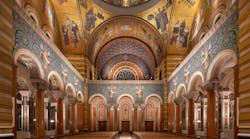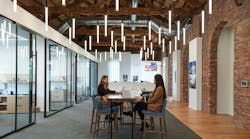Challenge: The camera closes in as Kevin Costner pushes aside vibrant green stalks and steps out of a cornfield onto a baseball field, followed by men in Chicago White Sox and New York Yankees jerseys. It is a clear August night in a small Iowa town. This scene sounds wildly familiar to fans of the 1989 movie Field of Dreams, but it’s not a recap of that classic film. It happened in real life, in 2021.
Designed by the architectural firm Populous, this temporary field was built to exacting MLB standards and hosted the most-watched regular season MLB game in 16 years. 8,000 people attended the event in person, while 5.9 million viewers enjoyed watching the New York Yankees take on the Chicago White Sox in the iconic Iowa setting from the comfort of their own homes.
“To bring this movie to life, we planned every last detail with MLB so the experience reflected the look and feel of the movie and created a spectacular setting for what was a phenomenal game. As we created this one-of-a-kind experience, we pushed past the standards of a neutral-site sporting event. We saw this as an opportunity to tap into our own imaginations and inspire spectators to do the same on game day,” says Todd Barnes, senior event architect, senior principal, Populous.
Influence: In every phase of this project, the design of the temporary ballpark was centered around creating lasting memories for both in-person spectators and those watching at home. “We also remained committed to shaping a responsible and intentional fan experience, and we cherished the cornfield-filled outfield views and the original movie site that sat approximately 250 yards away,” says Barnes.
To welcome as many spectators to the field as possible while preserving a backdrop of these cornfields, the project incorporated a mix of chair- and bleacher-style temporary seating. The design positioned the majority of the 8,000 spectators down the third base line with a view of the film’s field and farmhouse in the distance. The field is oriented towards the northeast, which is proper baseball orientation to allow for optimal sun angles and player views of the field.
The ballpark design also paid tribute to Chicago’s Comiskey Park, home of the White Sox from 1910 to 1990. The bullpens were designed behind a 12-ft. wall in center field, like the ones found in the old park. A barnwood scoreboard was installed in the right field.
Solution: Populous designed the master plan for the project, which connected the original movie site and the new regulation field through a full design process. “We completed the site and ballpark feasibility study and designed the ballpark and supporting structures. We set out to craft an exceptional fan experience with detail-oriented planning,” says Barnes.
Because the park is a demountable park, the design approach is quite different from permanent facility design and needed to consider and accommodate various uses of the space and maintain a flexible atmosphere. As plans shifted due to the pandemic, the game was postponed from 2020 to 2021. Team and player operations remained distanced and consumed more space as a result. The park was correctly sized for both health and safety reasons, as well as to ensure that spectators could responsibly travel in and out of Dyersville for the event. “The flexibility and adaptiveness of our design and team collaboration was paramount to this successful event,” says Barnes.
While “MLB at Field of Dreams” was intended to serve only one game, the field has hosted additional games since.
This article appeared in the May 2022 issue of Architectural SSL magazine.





